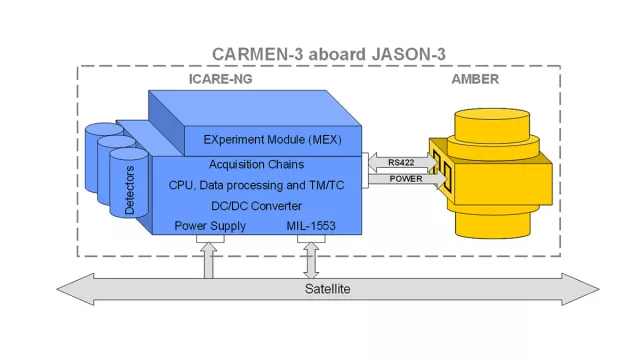The ICARE instrument operating on CARMEN missions measures solar and cosmic radiation reaching satellites in Earth orbit and beyond. It has both scientific and pragmatic value, improving environmental models and characterizing the mission’s radiation environment.
Key information
| Mission | Measure cosmic and solar radiation reaching satellites |
|---|---|
| Domain | Science |
| First flight | 20 June 2008 |
| Partners | EREMS, ONERA, STEEL Electronique |
| Where | On Jason-2, SAC-D, Jason-3, Eutelsat 7C, Hotbird 13 F and 13 G, model delivered for Lunar Gateway ICARE accomplished three previous missions (outside the CARMEN project) on Mir, the ISS and SAC-C |
| Lifetime | Approximately 8 years per mission |
| Status | In operation (on Jason-3, Eutelsat 7C, Hotbird 13 F and 13 G) |
Key figures
- 4 active satellites carrying CARMEN
- 1 to 4 instrument modules
- 2.4 to 5.3 kg mass of ICARE experiment
- 20 cm largest dimension of experiment
Key milestones
- TBD: Launch on ESA’s ERSA array for Lunar Gateway
- 3 November 2022: Launch on Hotbird 13G satellite by Falcon 9 (CARMEN-5)
- 15 October 2022: Launch on Hotbird 13F satellite by Falcon 9 (CARMEN-6)
- 20 June 2019: Launch on Eutelsat 7C satellite by Falcon 9 (CARMEN-4)
- 17 January 2016: Launch on Jason-3 satellite by Falcon 9 (CARMEN-3)
- 10 June 2011: Launch on SAC-D satellite by Delta II (CARMEN-1)
- 20 June 2008: Launch on Jason-2 satellite by Delta II (CARMEN-2)
Project in brief
CARMEN (CARactérisation et Modélisation de l'Environnement) is a modular instrument for measuring the space environment—high- and low-energy radiative particles, micro-debris, etc.—and its effects.
CARMEN-2, comprising an ICARE-NG radiation monitor, operated in Earth orbit at an altitude of 1,336 km on the Jason-2 altimetry satellite from 2008.
Another flight model, CARMEN-1, was carried aboard SAC-D, launched in 2011. CARMEN-1 consisted of an ICARE-NG radiation monitor and three SODAD micro-debris and micro-meteorite detection systems on three faces of the satellite.
A third model, CARMEN-3, was launched aboard Jason-3 on 17 January 2016. CARMEN-3 consisted of an ICARE-NG radiation monitor and an AMBRE plasma detector.
A fourth mission, CARMEN-4, took an ICARE-NG instrument with it on the Eutelsat 7C satellite, launched into geostationary orbit on 20 June 2019 and positioned using electric thrusters. It was the first time measurements had been acquired from this type of trajectory.
The most recent CARMEN experiments, CARMEN-5 and -6, with an ICARE-NG² instrument, are flying on the Hotbird 13F, 13G and Eutelsat 7C satellites, launched in late 2022 and positioned in geostationary orbit using electric thrusters. ICARE-NG² features a sensor designed especially to measure environmental conditions responsible for degrading solar arrays in transfer orbit.
Why fly CARMEN on these satellites?
Due to their altitude in low Earth orbit and their inclination, the satellites regularly fly through the South Atlantic Anomaly. This zone is populated at relatively low altitude by particularly aggressive particles—notably high-energy electrons and protons—likely to interfere with their extremely precise instruments. By measuring the levels of radiation these particles emit, CARMEN is helping to assess and if necessary correct their effects on satellite systems, like for example DORIS on Jason-2 and Jason-3.
For geostationary satellites, particularly during positioning phases with electric thrusters, CARMEN characterizes the environment, which is otherwise poorly understood for lack of missions in these regions of space. This environment varies and certain components are more aggressive than estimated by specification models. Moreover, this constraint is received at the start of the mission, before satellite positioning. CARMEN thus provides a “black box” able to record constraint levels.
CARMEN also has scientific value, as the flows of charged particles it measures serve as inputs to validate and enhance physical models of the Van Allen radiation belts. Such models are used to specify satellites’ orbital design constraints.
CNES’s role
As conceptor and prime contractor for the CARMEN instrument, CNES tasked French firm EREMS with construction of the CARMEN-2 (on Jason-2) and CARMEN-3 (on Jason-3) flight models. For CARMEN-1 (on SAC-D), EREMS built the main ICARE-NG instrument and STEEL Electronique the three SODAD micro-debris and micro-meteorite detection systems. CNES was instrument prime contractor for the CARMEN-4 experiment.
French national aerospace research centre ONERA (DPHY physics, instrumentation, environment and space department) was co-principal investigator with CNES for all of the ICARE instruments, contributing to the definition of detectors and to data exploitation.
CARMEN-5 and -6 are twin instruments, the first supplied by CNES and the second by ESA as part of France’s contribution to the Space Safety Programme (S2P), on the Hotbird 13F and 13G twin satellites. CNES was prime contractor for CARMEN-5. Under S2P and for CARMEN-6, the prime contractor was ONERA, with support from CNES.
The same organization is underway for CARMEN-7 destined for the Lunar Gateway as part of our contribution to S2P. It will also be put in place for a future CARMEN-9 destined for low Earth orbit, also for S2P.
After CARMEN-5 and -6 and their integration on the Hotbird satellites built by Airbus Defence & Space, Airbus now offers ICARE-NG² as an option on its geostationary spacecraft buses. The UK Ministry of Defence has ordered a CARMEN-8 model for Skynet 6 directly from EREMS, which has now acquired sufficient maturity to act alone as prime contractor. CNES has thus helped to foster a whole new industry.
CNES contacts
Project Leader
Robert Ecoffet
E-mail: robert.ecoffet at cnes.fr
Sun, Heliosphere and Magnetosphere subject matter expert
Kader Amsif
E-mail: kader.amsif at cnes.fr


